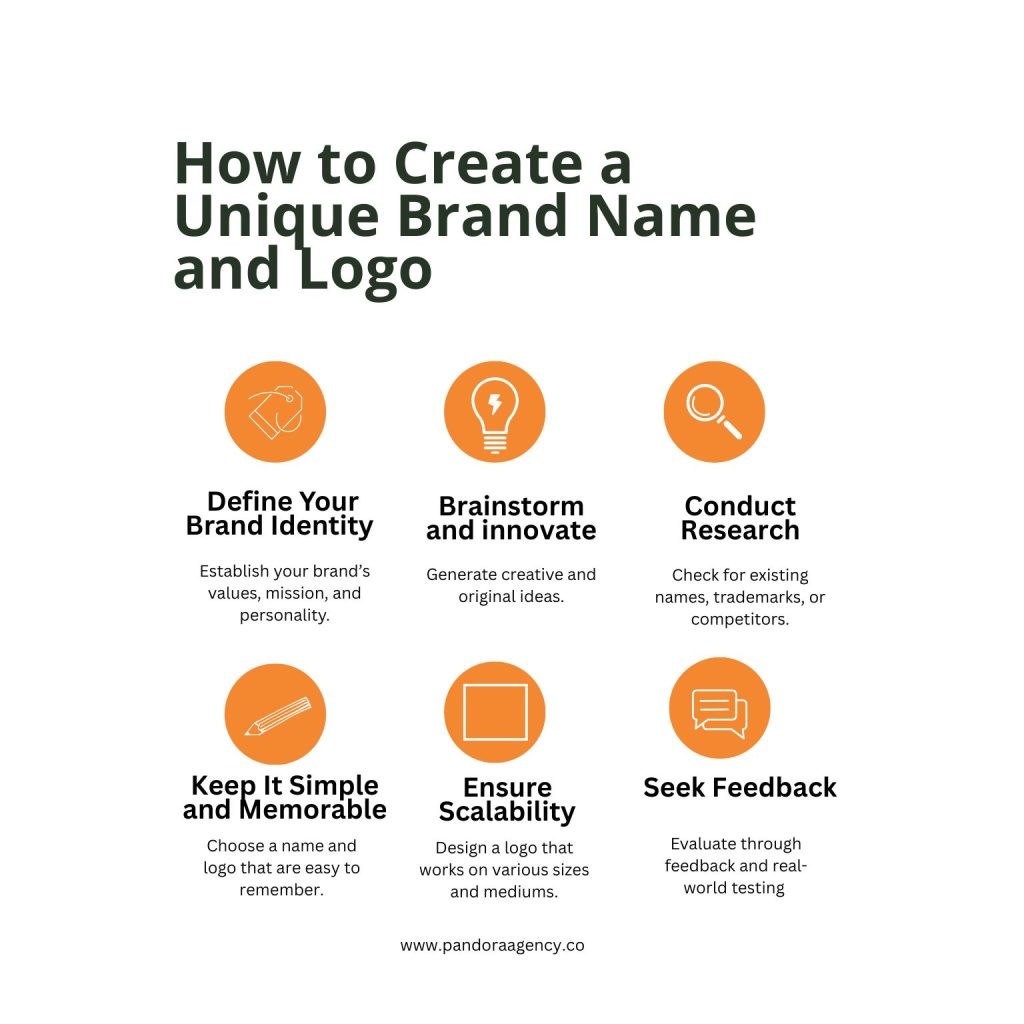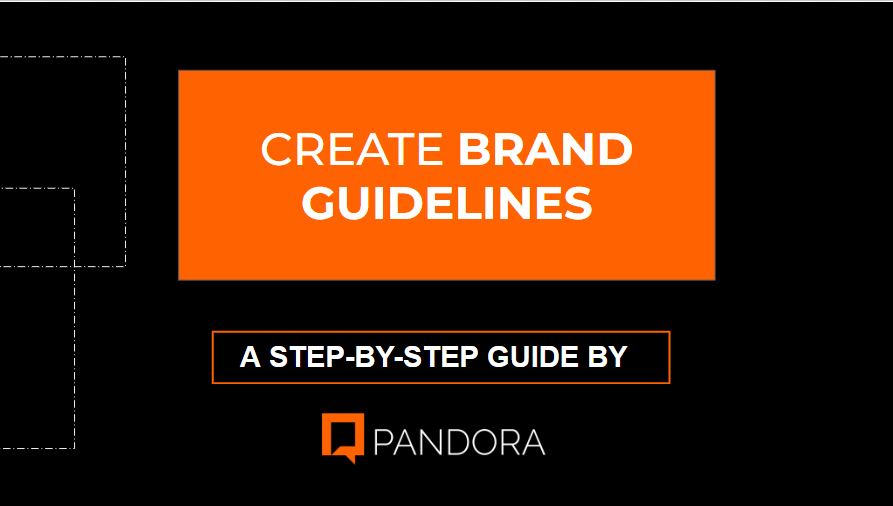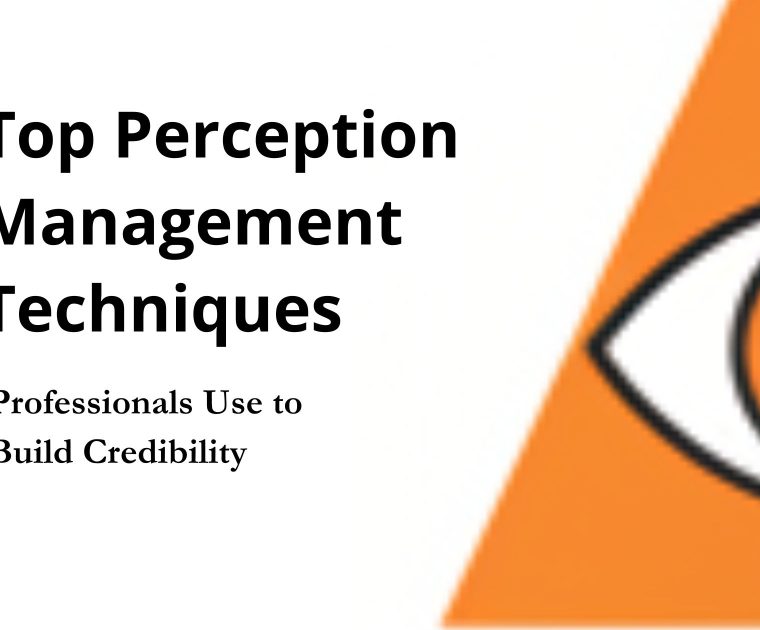Creating a unique brand name and logo isn’t a simple task that can be pulled off in minutes. This process requires a blend of creativity, strategy, and a deep understanding of your brand’s identity and target audience.
All these, mixed together, will help you create a brand name and logo that is memorable and beautiful.
Some people skip this process and just hand over logo designs to a graphic designer without having a sketch and carefully communicating what they want.
And when it comes to brand names, some people go into that blindly, taking a random guess to whatever may fit.
That’s not what we want for your brand, and you should too. You should yearn for a brand name and logo that is eye-catching, memorable and gets the job done.
Ready to get started? Let’s go!
Have You Downloaded Our Personal Branding Guide?

6 Tips For Creating a Unique Brand Name and Logo

Don’t know where to start? We have drafted this article just for you. Below are tips to help you create a unique brand name and logo that’s to die for.
1. Define Your Brand Identity
Before creating names and logos, take time to establish your brand’s core identity. This foundation ensures your brand name and logo will authentically represent who you are and resonate with your audience.
- Start With Your “Why”
Develop clear mission and vision statements that articulate your purpose and long-term goals. For example, Patagonia’s mission statement, “We’re in business to save our home planet,” immediately establishes their environmental commitment, which is reflected in their mountain-silhouette logo and nature-focused name.
- Next, Define Your Core Values
Identify 3-5 fundamental principles that guide your business decisions. Consider:
- Are you innovative or traditional?
- Serious or playful?
- Exclusive or accessible?
Example: Airbnb’s core values of belonging and community influenced its “Bélo” logo symbol, which represents “people, places, love, and Airbnb,” while its name evolved from the founders’ original concept of “Air Bed & Breakfast.”
- Research Your Target Audience
Create detailed audience personas by:
- Conducting surveys and interviews with potential customers
- Analyzing competitors’ audiences and identifying gaps
- Using demographic and psychographic data to understand preferences
Real-world application: When Dollar Shave Club launched, they understood their target audience of practical, value-conscious men who were tired of overpriced razors.
Their straightforward name communicated value, while their simple logo reflected their no-nonsense approach, perfectly aligning with their audience’s priorities.
- Develop a Positioning Statement
Craft a one-paragraph statement that captures:
- Who your customers are
- What category do you operate in
- Your key benefit/differentiator
- Evidence supporting your claims
When evaluating potential brand names and logo concepts, this statement becomes your north star.
2. Brainstorm and Innovate
Now that you’ve defined your brand identity, it’s time to create something truly distinctive. Brainstorming isn’t just about thinking; it’s your opportunity to transform your brand vision into tangible concepts.
Start by setting aside dedicated time for creativity without distractions. Whether you work best with quiet reflection or collaborative energy, create an environment that sparks your imagination.
Instead of following trends, focus on what makes your brand special. Ask yourself: “What name would make someone curious to learn more?” or “What visual element would instantly connect with our values?”
Keep your brainstorming sessions focused but open-minded. Write down every idea, even ones that seem impractical at first.
Often, the perfect brand name or logo concept emerges from combining or refining initial thoughts that didn’t immediately shine.
Remember that the goal isn’t quantity but quality; you’re searching for concepts that authentically represent your brand while standing apart from competitors in a memorable way.
You can use brainstorming techniques like word association, mind mapping, and freewriting.
Aiming for originality can also help you craft a unique brand name and logo. You can do this by thinking outside the box and striving to come up with ideas that aren’t in vogue yet.
Try to avoid clichés and overused motifs in your industry to ensure your brand stands out.
Example
For instance, let’s say you want to start a sustainable skincare brand with a mission to provide affordable, eco-friendly products and a vision of promoting global environmental responsibility.
You can use this information as a guide to creating a unique brand name and logo.
You could come up with a brand name like “EcoGlow,” as it combines sustainability and beauty. On the other hand, the logo can feature a leaf and water droplet in green and blue tones.
This process ensures your brand name and logo perfectly represent your brand’s essence and resonate with the target audience.
3. Conduct Thorough Research
After writing out your ideas and creating your logo concepts and sketches, the next thing to do is research. You can’t avoid conducting thorough research, especially if you want to create a unique brand name and logo.
Conducting thorough research is important so you know if your ideas are already in existence and don’t waste your time designing and creating your goals around them.
The first thing you want to do is Trademark Search. This search helps you determine if a logo, slogan, or brand name you’ve chosen is already registered and in use.
A trademark search is important to help you dodge any legal issues and ensure that your brand is unique. Trademark searches can be done either through a national trademark office or a private trademark search service.
You can get ideas for your brand name and logo from your competitors, too. All you have to do is analyze your competitors’ names and logos to identify gaps and opportunities. But you must ensure that what you come up with differentiates you from others in the market.
Watch the Animated Version of this Article
4. Keep It Simple and Memorable
Some people struggle with keeping their brand names simple. They feel like the more words they add, the better people are going to understand what their brand is about. And some say that some names are personal, that’s why they must be included in the brand name.
But it doesn’t work that way. Having more names squeezed into the brand name complicates things and makes remembrance harder, hence mitigating the efforts of brand awareness. Complicated brand names are difficult to remember and share.
For instance, these brand names don’t sound like the ideal brands people would quickly remember:
- Xyroquintech Solutions Incorporated
- Luminarium Essentials
- Nutraceutical Innovations
Instead, you should choose a name that is easy to spell and pronounce. This makes remembering the brand easy. In other words, keeping your brand name simple, say one or two words, will help your brand awareness efforts stick.
Brand names like these are more likely to be remembered:
- GlowFly
- Leafy
- Pulse
And when it comes to logos, a simple and clean logo design always tends to be more recognizable and versatile. Aim for something that’s able to convey your brand message in the simplest way possible.
5. Ensure Scalability and Versatility
This tip is dedicated to your brand logo design because they are as important as your brand name. When creating your logo or instructing the graphic designer, ensure your logo looks good at any size, from a small social media icon to a large billboard. It should retain clarity and impact whether it’s printed on a business card or displayed on a website.
This can sound unimportant, like something that can be handled in one quick fix. But, believe me, people feed on content with their eyes and first impressions are lasting impressions.
I bet you don’t want to be known as that brand with a blurry logo. Besides, new AI features like Circle To Search may not be able to identify your brand if you have a blurry logo.
One easy way of falling victim to owning a blurry logo is underpricing your graphic designer or not paying for high-quality downloads from graphic designing tools.
To be frank, if you want quality, you have to pay for quality. Remember, it’s your brand’s image we’re talking about here. Imagine if your face was blurry on a video call; how do you imagine the conversation would go?
Also, keep versatility in mind. Your logo should be adaptable to various backgrounds and contexts. Consider how it will appear in black and white as well as in color. Also consider how it would appear on a white, black, or transparent background.
6. Seek Feedback and Test
You’re not an island. You need to gather feedback and run tests if you truly want to create a unique brand name and logo that can be remembered.
So share your potential brand names and logo designs with trusted peers, industry experts, and potential customers to gather feedback. Their feedback can provide insights into how your brand is perceived and its potential impact.
For tests, you need to use your brand name and logo in various contexts, such as on social media, mock-ups of packaging, and marketing materials. This will help you see how they perform in real-world scenarios.
Don’t forget to make necessary adjustments as you get feedback from people and results from tests. We grow and learn on the job.
Need a Free Brand Guideline Template?

Final thoughts
Developing a unique brand name and logo is a critical step toward establishing a strong and memorable brand identity. You have to start by laying a solid foundation by defining your brand’s essential values and determining your target audience.
Engaging in creative thinking and aiming for simplicity guarantees that your brand stands out and is memorable. Ensuring scalability and versatility ensures that your logo retains its impact across all platforms and sizes.
Conducting extensive research allows you to avoid legal ramifications and distinguish your business from the competition.
Finally, soliciting input and testing in real-world circumstances enables fine-tuning and improves the overall effectiveness of your brand identity.
Following these steps will assist you in developing a distinct and impactful brand that connects with your target audience and endures over time.






Very good article, but you forgot to mention the use of business name generators that use AI like Namelix to generate name ideas. They can be very helpful in finding a new name for a project.